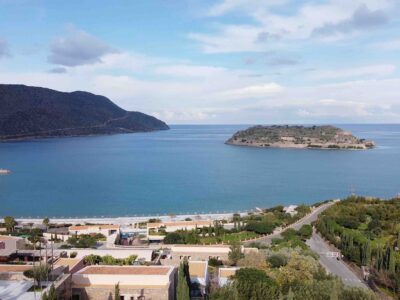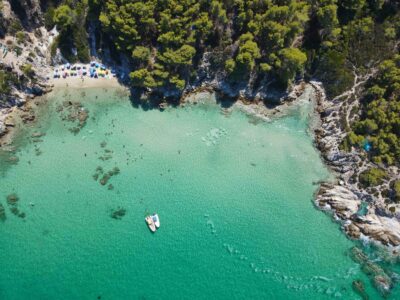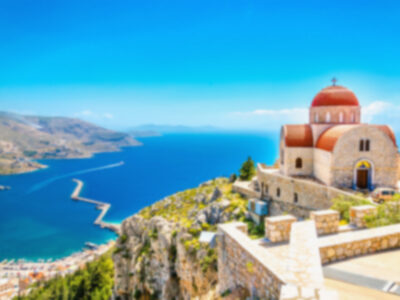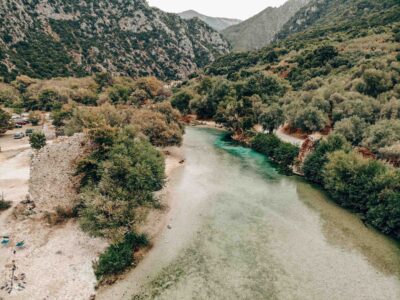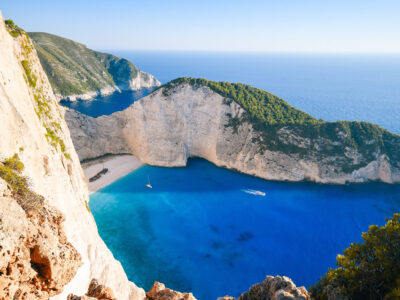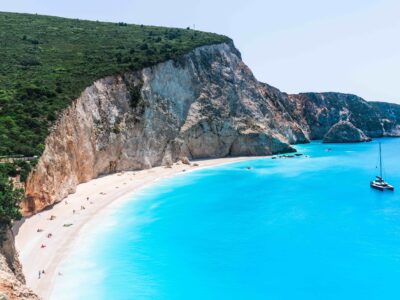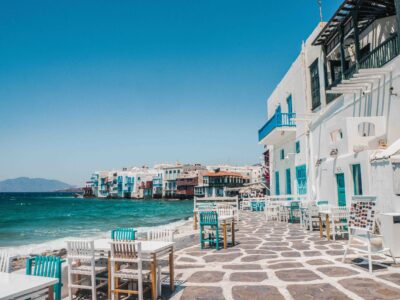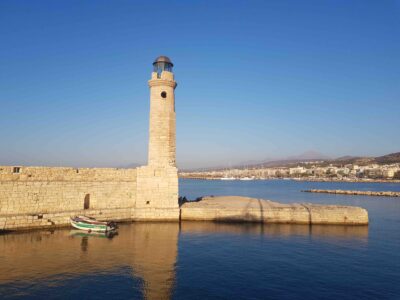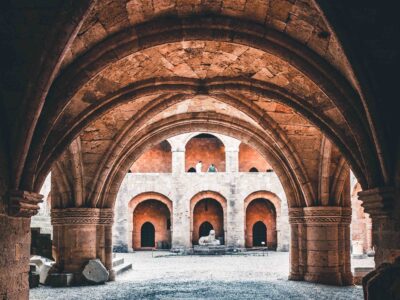Greek Island Archaeological Tours
Greece is where antiquity meets the azure sea under a cerulean sky.
Greece It's a land steeped in myths. Every island tells a tale, imbued with ancient Greek lore where heroes walked, and gods played amidst the Mediterranean's sun-kissed beauty. Here, amid these storied landscapes, one can tread the path of history, encountering architectural wonders that echo the tales of a bygone era, as they stand in silent testament to the country's rich heritage.
Unveiling the Cyclades' Secrets
The Cycladic islands, an Aegean archipelago, are shrouded in histories not only of the people that settled there but of the civilizations that thrived and waned like the tides. Delos, the sacred island of Apollo, offers an unparalleled journey into antiquity where majestic temples and iconic terraces whisper secrets of the ancient world.
To set foot on these islands is to step into a narrative tapestry; myths are etched in stone and marble across the Cyclades. At Akrotiri on Santorini, frescoes and artifacts reveal a sophisticated Minoan society, while on Naxos, the unfinished Temple of Apollo stands as a sentinel of Hellenic glory. Delving into these realms removes the veils of time, presenting an intimate glance into the lives of those who contributed to the esteemed narrative of Greek civilization.
Delos: Apollo's Sacred Island
Delos stands as a timeless beacon—secluded—yet echoing the grandeur and mystique of ancient Greek civilization.
Amidst the Aegean, Delos was the birthplace of the divine twins, Apollo and Artemis, bestowing upon the isle an everlasting sacredness.
An archaeologist's canvas, the island bears seminal edifices and intricate mosaics that narrate the stories, myths, and rituals once central to sacred proceedings.
Enshrined within its silent ruins, the Terrace of the Lions guards the sacred way—a vigilant testament to the protective deities that once surveyed over Delos.
Santorini: Beyond the Caldera
Discover remnants of antiquity beyond the stunning views.
Santorini, famed for its dramatic caldera and sunsets, harbors deeper historical riches. The island is a treasure trove of advanced Bronze Age civilization, exemplified by the well-preserved ruins of Akrotiri. Evidently, cultural sophistication flourished on the island long before the caldera's creation in the cataclysmic Minoan eruption.
Akrotiri reveals a Minoan city frozen in time.
The site of Akrotiri is intriguing, not merely for its historical value but also for the insights it provides into ancient urban planning and art. Here, multi-storied buildings, sophisticated drainage systems, and vivid frescoes showcase a civilization that was unexpectedly advanced.
Explore a crossroad of ancient maritime routes.
Santorini's strategic position in the Aegean allowed it to thrive as a commercial hub. Its archaeological layers tell tales of exchanges with distant cultures, illustrating how the island was a key player in the Bronze Age's complex trade networks.
Your journey through time awaits in 2023.
Should you consider experiencing Santorini's archaeological wonders, planning your visit for 2023 would align with several informative exhibitions and enhanced visitor facilities. This journey into the past promises an enriching narrative supplemented by the latest in archaeological research and immersive technology.
Crete's Minoan Mysteries
One cannot help but be captivated by the labyrinthine complexity of Knossos, the epicenter of Minoan civilization. In this extensive archaeological site, the storied palace complex, with its grand courtyards, intricate frescoes, and myth-enshrouded Labyrinth, whispers of an era when this island was a potent nucleus of seafaring and culture.
The remains of Minoan Crete enkindle the imagination, drawing visitors through time into the throes of an ancient society both enigmatic and advanced. Delicate pottery, sophisticated town layouts, and undeciphered Linear A tablets encompass only a fraction of the treasures that await exploration on this island where history and legend intertwine.
Knossos: Labyrinth of Legends
Knossos, the largest Bronze Age archaeological site on Crete, invites travelers to navigate its storied pathways and delve into ancient myths.
- Explore the Grand Palace with its ceremonial and residential quarters
- Marvel at the Frescoes depicting scenes from Minoan life
- Witness the Throne Room, potentially linked to the legendary King Minos
- Unravel the mysteries within the storied Labyrinth, said to house the Minotaur
- Contemplate at the Royal Chambers where royalty once walked
- Examine the intricate Storage Jars that underscore the Minoan's commercial prowess
- Study the engineering marvel of the ancient Drainage Systems
Envision the splendor of Minoan civilization through the remnants of this ancient center of commerce and governance.
Uncover a world where history and legend merge, crafting a narrative as captivating as the myths of gods and heroes that echo through these ancient halls.
Phaistos: Echoes of Hieroglyphs
Phaistos discloses a tale of cryptic language through its enduring hieroglyphs, inviting linguists and history buffs alike to ponder its meanings.
Discover the Phaistos Disc, shrouded in enigmatic symbols and debate.
Ancient inscriptions hint at early writing systems, predating the renown of Mycenaean Linear B script. The site challenges visitors to contemplate the evolution of communication in antiquity.
Phaistos provides a tangible connection to the past where each hieroglyph serves as a portal to ancient insights. As you wander amidst these ruins, the whispers of the Minoan civilization resonate, conjuring images of priests and scribes engaged in their sacred crafts. Here, nestled in southern Crete, the ruins hold keys to understanding a sophisticated and enigmatic culture, offering glimpses into a bygone era that was grounded as much in complexity as it was in mystique.
Dodecanese Discoveries
Embarking on an archaeological tour of the Dodecanese archipelago unveils a mosaic of ancient cultures, delicately preserved through time. On islands like Rhodes and Kos, the intersecting layers of history unfold. Unveil the imposing Acropolis of Lindos on Rhodes, its Doric Temple of Athena Lindia commanding respect beneath an azure sky. Nearby, the Ancient Agora unveils a commercial hub steeped in antiquity. On Kos, the Asclepeion whispers tales of ancient healing, where Hippocrates, the father of medicine, once walked. This eastern frontier of Greek civilization marries breathtaking views with profound historical substance, offering an unparalleled journey through time for every explorer.
Rhodes: Citadel of the Knights
Rhodes, an island imbued with a chivalric aura, harbors a medieval old town enclosed by a formidable city wall, a testament to its prestigious history. This World Heritage site is a palimpsest of different eras, where each stone whispers narratives of the past.
Navigating through the cobblestone alleyways, one enters the domain of the Hospitallers. Their presence still lingers in the extensive fortifications and grand edifices they left behind.
Within these walls, the Palace of the Grand Master stands dominant - a medieval castle reborn from ancient ruins. Its architecture, infusing Gothic with local elements, reflects the eclectic history of Rhodes.
The Street of the Knights, or Ippoton, leads to a synthesis of Gothic and Renaissance influences. Here, the inns of the various ‘tongues’ of the Order sheds light on a cosmopolitan medieval society under the umbrella of Christianity.
Engage with the historical narrative at sites like the Archaeological Museum of Rhodes, where artifacts and exhibits unravel centuries of heritage. Walking through the museum grounds, once a hospital of the Knights, cultivates a profound connection with medieval Rhodes.
Ultimately, one cannot help but marvel at the strategic genius of the Knights' fortifications. Their legacy endures through powerful stonework and enchanting stories, beckoning travelers deeper into the heart of this majestic island.
Kos: Asclepius’ Sanctuary
The ancient island of Kos harbors the venerable sanctuary of Asclepius, emblematic of Hellenic healing rituals and knowledge. A place where medicine and spirituality once coalesced, the site remains a testament to antiquity's advanced understanding of health and wellness.
Built in honor of the deity of medicine, the Asclepeion served as a pan-Hellenic sanatorium, attracting a myriad of pilgrims seeking cures and relief through divine intervention. Among its fabled visitors was the father of medicine, Hippocrates, who is believed to have begun his groundbreaking work within these hallowed precincts.
Stepping into the Asclepeion, one traverses the physical layers of history; the ascending terraces lead through three levels, reflecting a journey from earthly woes towards divine wisdom. These stages culminate in the uppermost tier, where temples and altars once commanded awe-inspiring views over the Aegean Sea.
The vestiges of the complex reflect a sophisticated design, intertwining sacred architecture with therapeutic landscapes. Accompanied by whispers of Hippocratic teachings, visitors can explore remains like Roman baths, a medical school, and intricately carved columns rising into the clear Kos skies.
In the serenity of this archaeological marvel, the echoes of ancient rites merge with the present, inviting contemplation and a deeper appreciation for the origins of Western medicine. The Asclepeion of Kos remains a pillar of the classical world, enduring through centuries as a beacon of healing and wisdom.
Ionian Jewels
Perched upon the Ionian Sea, the islands beckon with layers of untold stories deeply rooted in classical antiquity. Here, amidst verdant landscapes and sapphire waters, lie the remnants of splendid civilizations, from the oracle sanctuaries of Kefalonia to the cyclopean walls that guard Zakynthos' past. These sites, sequestered across the Ionian archipelago, offer a rich tableau of Hellenic heritage waiting to be rediscovered by the discerning traveler.
Legends are etched into the very stones of Ithaca, where Homeric odysseys resonate through time. Each archaeological gem presents a mosaic of history, culture, and myth, shaping the narrative of human endeavor that has sculpted the islands' identity. An exploration here is both a voyage back in time and an encounter with the timeless beauty of the Greek Ionian isles.
Kefalonia: Odysseus' Homeland
Kefalonia boasts a mythological backdrop against which a palpable sense of history unfolds.
- Samis: Unearth artifacts in the ancient acropolis, a stronghold of bygone civilizations.
- Drogarati Cave: Marvel at this subterranean geologic wonder, linked to mythical narratives.
- Ainos Mountain: Traverse the sacred paths once allegedly roamed by Odysseus himself.
- Melissani Cave: Glide over the crystalline waters of this mystical cave, steeped in legends.
- Roman Villa in Skala: Walk amongst the opulent remnants of Roman aristocracy.
Here, archaeological pursuits converge with epic tales, inviting discovery.
The island whispers tales of a storied past, where every ruin and relic holds a tale waiting to be told.
Corfu: Crossroads of Civilizations
Corfu, a tapestry of cultural influence, offers a rich archaeological narrative.
- Paleopolis: Delve into the ancient city that stood at Corfu's heart during classical times.
- Mon Repos: Wander through the remnants of a neoclassical palace amidst ancient ruins.
- Angelokastro: Ascend to this Byzantine fortress offering insights into medieval strategic defense.
- Achilleion Palace: Explore a palace infused with mythological motifs, built for a grieving Empress.
Historic threads from Greek, Venetian, French, and British epochs intertwine here.
Through its diverse ruins, Corfu reveals layers of history that shaped the Ionian Sea's narrative.

